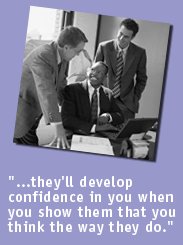
Payoff Trees Help Make Sales
| ¤ţńÓŠŔ | ||||
| Sales.com | ||||
| Answers... | ||||
by Michael W. Lodato, Ph.D.
 Selling
Benefits
Selling
Benefits
You can increase your sales by teaching your salespeople to list prospect benefits and payoffs associated with each feature of the products they sell. Two effective techniques to help salespeople concentrate on benefits are the So What? Test; and the Because of ..., you get ... relationship.
So What? Test challenges you to ask yourself, "So What?" about every statement you make about your product. Challenge your sales talk, contents of brochures, ads, sales letters, and so on.
Try it right now. Look at a couple of your own ads, or some from a trade journal, and I'll bet the "So What?" challenge will expose some ads that are not benefits oriented. Fun, isn't it?
The Because of...you get... relationship gets you into the habit of putting the words "Because of" in front of any statement of fact or explanation of a feature of your offer. You will then have to complete the sentence by listing one or more benefits. Here are some examples.
Never assume that prospects know any or all of the benefits associated with any feature. Even if they do, they'll develop confidence in you when you show them that you think the way they do.
Beyond Benefits
It has been proven timeľandľagain that relating benefits to features increases sales performance. However, some years ago, I developed another set of relationships that I'm convinced will be even more effective than the featureľbenefits technique. I incorporate these relationships in what I call the MWL Payoff Tree.
It centers on processes, which are actions performed by a potential user of your product or service. For example, processes in inventory control include, ordering, receiving, and maintaining stock balances, all of which would be affected by an inventory control system.
In the sample in Figure A, processes in general accounting are shown, namely: "prepare balance sheet," "prepare income statements" and "post payments received". These sound like features that may even be identified by the same words.
But don't fall into the trap of thinking they are the same things. A feature is something you provide. A process is something the user does, and hence is much more interesting to him or her.
One of the things I like about Payoff Trees is that you don't find features hanging on them. Features are only mentioned as sources of benefits.
A benefit is a positive impact on a process that would result from use of your product or service. Benefits accrue to organizations rather than people. They are usually quantifiable. They tend to be logical.
Examples of benefits from an automated inventory control system are higher customer service, greater profits, lower inventory carrying cost and improved market share. In Figure A, three of the possible benefits from a general ledger system relative to the process of producing an income statement are that:
than before installation of the system. These satisfy the definition of a benefit in that they accrue to the organization, are easily measured, and are logical results of the new system.
Individual Payoffs
A payoff is a positive effect to an individual that results when the organization accrues a benefit. Payoffs differ from benefits in that they accrue to individuals, are not usually quantifiable, and tend to be emotional rather than logical.
The same benefit may have different payoffs to different individuals in the same organization.
Examples of payoffs are reduced frustration, free weekends, fewer late nights, and higher respect from peers. In Figure A, two payoffs that could accrue to a controller from issuing the financial statements sooner are less pressure from others for the numbers, and better performance reviews from the controller's superior.
Note that these payoffs are individual, are not quantifiable and appeal to the emotions.
A recipient is one who is affected by the benefits and can perceive one or more payoffs from it. Figure A identifies three people would likely be affected by having income statements produced earlier than before. It is likely that each would perceive a different set of payoffs from that one benefit.
One of the basic tenets of selling is that people (recipients) buy because of payoffs. They use benefits to justify their purchase.
Take the time to build an MWL Payoff Tree for each of your products. You will then know how to approach each person in the prospect organization who can influence the sale.
And preparing sales letters, brochures, ads, flyers, etc. becomes a breeze. All you have to do is pick arguments off your MWL Payoff Tree.
Figure A: MWL Payoff Tree
